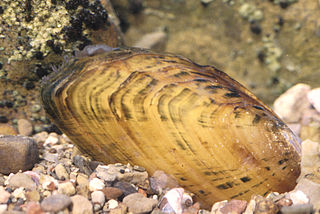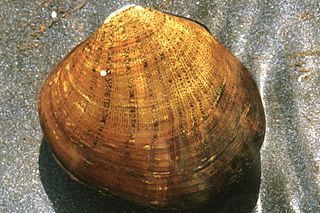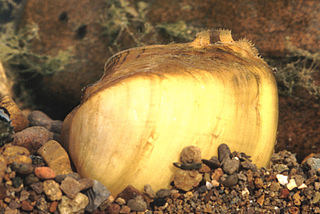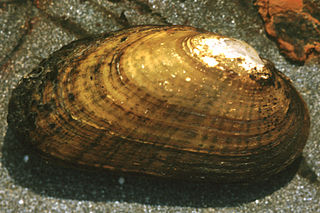
Bivalvia, in previous centuries referred to as the Lamellibranchiata and Pelecypoda, is a class of marine and freshwater molluscs that have laterally compressed bodies enclosed by a shell consisting of two hinged parts. As a group, bivalves have no head and they lack some usual molluscan organs, like the radula and the odontophore. The class includes the clams, oysters, cockles, mussels, scallops, and numerous other families that live in saltwater, as well as a number of families that live in freshwater. The majority are filter feeders. The gills have evolved into ctenidia, specialised organs for feeding and breathing. Most bivalves bury themselves in sediment, where they are relatively safe from predation. Others lie on the sea floor or attach themselves to rocks or other hard surfaces. Some bivalves, such as the scallops and file shells, can swim. Shipworms bore into wood, clay, or stone and live inside these substances.

The Unionidae are a family of freshwater mussels, the largest in the order Unionida, the bivalve molluscs sometimes known as river mussels, or simply as unionids.

The cracking pearlymussel is an endangered species of freshwater mussel, an aquatic bivalve mollusk in the family Unionidae.

Sinanodonta woodiana, the Chinese pond mussel, Eastern Asiatic freshwater clam or swan-mussel, is a species of freshwater mussel, an aquatic bivalve mollusk, in the family Unionidae.

Arcidens wheeleri is a species of freshwater mussels in the family Unionidae, the river mussels. Its common names are the Ouachita rock pocketbook and Wheeler's pearly mussel. The former monotypic genus of Arkansia was named for the state of Arkansas, where the mussel was first discovered.

Dromus dromas, the dromedary pearlymussel or dromedary naiad, is a rare species of freshwater mussel in the family Unionidae. This aquatic bivalve mollusk is native to the Cumberland and Tennessee River systems in the United States, where it has experienced a large population decline. It is a federally listed endangered species of the United States.

The oyster mussel is a rare species of freshwater mussel in the family Unionidae. This aquatic bivalve mollusk is native to the Cumberland and Tennessee River systems of Kentucky, Tennessee, Alabama, and Virginia in the United States. It has been extirpated from the states of Georgia and North Carolina. It is a federally listed endangered species of the United States.

Lampsilis ovata, or pocketbook mussel, is a species of freshwater mussel, a bivalve mollusk in the family Unionidae, the river mussels. This species is endemic to eastern North America.
Lampsilis rafinesqueana, the Neosho mucket or Neosho pearly mussel, is a species of North American freshwater mussel endemic to Arkansas, Oklahoma, Illinois, Missouri and Kansas.

Sagittunio nasutus, the eastern pondmussel, is a species of freshwater mussel in the family Unionidae, the river mussels.

Ligumia recta is a species of freshwater mussel, an aquatic bivalve mollusk in the family Unionidae, the river mussels.

Margaritifera auricularia is a species of European freshwater mussel, an aquatic bivalve mollusk in the family Margaritiferidae, the freshwater pearl mussels. Formerly found throughout western and central Europe, the species is now critically endangered and is one of the rarest invertebrates worldwide, being confined to a few rivers in Spain and France. M. auricularia is commonly known as Spengler's freshwater mussel in honour of Lorenz Spengler, who first described this species.
The triangular kidneyshell is a species of freshwater mussel, in the family Unionidae, the river mussels. It is endemic to Alabama in the United States, where it is known from several rivers and streams in the Mobile River Basin. It is a federally listed endangered species of the United States.

Villosa iris, the rainbow mussel or rainbow-shell, is a species of freshwater mussel, an aquatic bivalve mollusk in the family Unionidae, the river mussels. In 2018, Watters proposed to move the species into a new genus, Cambarunio.
Islamia graeca is a species of small freshwater snail with a gill and an operculum, an aquatic gastropod mollusc or micromollusc in the family Hydrobiidae.
Islamia trichoniana is a species of small freshwater snail with a gill and an operculum, an aquatic gastropod mollusc or micromollusc in the family Hydrobiidae.

Microcondylaea is a genus of freshwater mussels in the family Unionidae, the river mussels.

Unio mancus is a species of freshwater mussel, an aquatic bivalve mollusk in the family Unionidae, the river mussels.
















